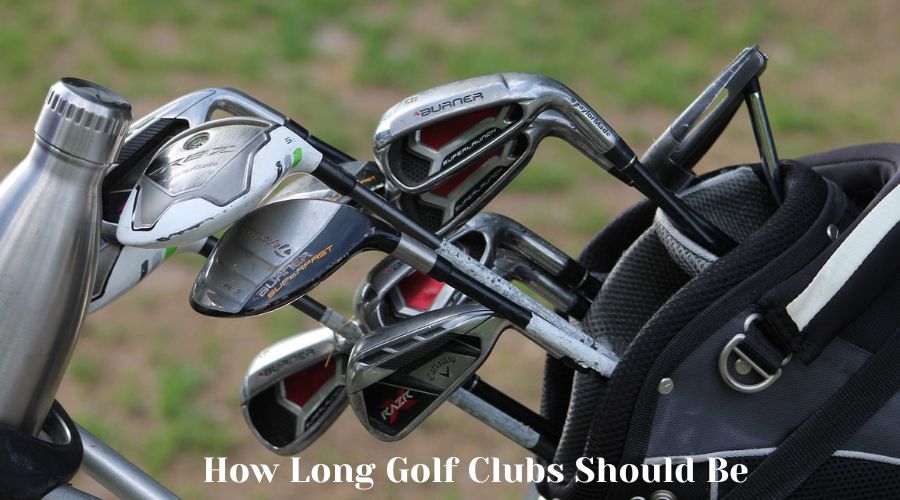Golf clubs vary in length based on the type of club and the player’s height. Standard drivers for men typically range from 45-48 inches.
Selecting the right golf club length is crucial for optimizing performance and comfort on the course. The appropriate length can enhance swing mechanics, accuracy, and overall game enjoyment. It is essential for golfers to consider their height, swing style, and physical capabilities when choosing club length.
Manufacturers offer clubs in various lengths to accommodate the diverse needs of players. Custom fitting sessions are invaluable for determining the ideal club length, ensuring each golfer achieves a tailored fit for their unique swing. By prioritizing the correct golf club length, players can significantly improve their golfing experience.
Contents
- 1 The Importance Of Golf Club Length
- 2 Factors Influencing Club Length
- 3 Measuring For The Right Fit
- 4 Height Vs. Club Length Relationship
- 5 Analyzing Strike Patterns
- 6 Shaft Length Experimentation
- 7 Tempo And Swing Plane
- 8 Choosing The Right Club Length
- 9 Golf Club Length For Drivers And Woods
- 10 When To Get Fitted
- 11 Maintenance And Adjustment
- 12 Frequently Asked Questions
- 13 Conclusion
The Importance Of Golf Club Length
The Importance of Golf Club Length
Getting the right golf club length is crucial for any player. It can transform your game by improving accuracy, distance, and overall swing mechanics. Clubs that match your body type and swing style lead to better performance and more enjoyable rounds.
The impact on your swing
The Impact On Your Swing
Club length influences your stance and swing path. The right length allows a natural posture and fluid motion, reducing the risk of injury. Short clubs may cause a hunched back, while long clubs can lead to an overextended swing.
Common misconceptions
Common Misconceptions
- Longer clubs always hit further: Not true. Optimal length ensures control and power.
- Taller players need longer clubs: Height is a factor, but wing span and playing style also matter.
- Standard clubs fit most: Many golfers benefit from custom-fitted clubs tailored to their unique swing.
Factors Influencing Club Length
Finding the right golf club length is crucial for comfort and performance. Several factors come into play when determining the ideal length for a golfer’s clubs. Below are key considerations to ensure you get the perfect fit.
Height Considerations
Height is a primary factor in selecting the right club length. Taller players typically require longer clubs, while shorter players may benefit from shorter ones. Clubs should match your height to optimize your stance and swing.
| Height | Recommended Club Length Adjustment |
|---|---|
| Below 5’5″ | 1/2″ Shorter |
| 5’5″ – 6’1″ | Standard Length |
| Above 6’1″ | 1/2″ Longer |
Wrist-to-floor Measurement
The wrist-to-floor measurement is another vital metric. It helps to determine the appropriate club length based on the distance from your wrist to the ground. This measure considers both height and arm length.
- Stand straight on a flat surface.
- Let arms hang loosely at your sides.
- Measure from the crease of your wrist to the floor.
- Longer measurement: Longer clubs may be needed.
- Shorter measurement: Shorter clubs could be better.
Measuring For The Right Fit
Getting the right fit in golf clubs is crucial for your game. The correct club length improves accuracy, consistency, and comfort. Let’s explore how to measure for the right fit.
Tools needed for measurement
Tools Needed For Measurement
Before starting, gather these tools:
- Tape measure – to determine club length
- 48-inch ruler – for more precise measurement
- Club-sizing chart – to compare your measurements
Step-by-step guide
Step-by-step Guide
Follow these steps to measure your golf clubs:
- Stand straight with your arms hanging relaxed.
- Measure wrist-to-floor distance using the tape measure.
- Place the golf club in the address position.
- Align the 48-inch ruler with the club at the heel.
- Ensure the ruler runs up the shaft to the grip cap.
- Read the length where the ruler meets the grip cap.
- Compare your measurement with the club-sizing chart.
| Wrist-to-Floor Measurement | Suggested Club Length |
|---|---|
| 34″ – 36″ | Standard Length |
| 32″ – 34″ | 1/2″ Shorter than Standard |
| 36″ – 38″ | 1/2″ Longer than Standard |
| 38″ – 40″ | 1″ Longer than Standard |
Height Vs. Club Length Relationship
Understanding the Height vs. Club Length Relationship is crucial for all golf players. This relationship ensures that the club is a comfortable extension of the player’s body, enhancing both the comfort and effectiveness of their swing.
Using Height As A Starting Point
The first step in selecting the right golf club involves measuring your height. Golf clubs are designed to match the height of the player to provide optimum swing dynamics.
| Height Range | Club Length |
|---|---|
| Less than 5’0″ | Minus 1 inch |
| 5’0″ to 5’5″ | Standard |
| 5’6″ to 6’0″ | Plus 1 inch |
| Above 6’0″ | Plus 1.5 inches |
Adjustments For Stance And Swing
Not every golfer’s stance and swing are the same, even if their height is similar. Personal adjustments to the club length may be needed.
- Stance: Wider stances might require longer clubs.
- Swing type: A more upright swing may need a shorter club.
Testing different club lengths with a professional can help fine-tune these aspects to match your unique playing style.
Analyzing Strike Patterns
Golfers know that consistency is key. A crucial aspect of achieving that consistency is understanding strike patterns. The point where the club contacts the ball can significantly impact your game. This section delves into how the length of your clubs can affect where you strike the ball and how to optimize it for the best performance.
Effect of club length on strike location
Effect Of Club Length On Strike Location
Club length plays a pivotal role in determining the strike location on the clubface. A club that’s too long or too short can lead to off-center hits. These mishits can result in reduced distance and accuracy.
- Longer clubs can cause toe-side strikes.
- Shorter clubs may lead to heel-side impacts.
| Club Length | Common Strike Location |
|---|---|
| Long | Toe-side |
| Standard | Center |
| Short | Heel-side |
Perfecting club length tailors your gear to your swing, promoting a center-face strike pattern.
Optimizing strike pattern with correct length
Optimizing Strike Pattern With Correct Length
Finding the correct club length is essential for an optimized strike pattern. Here’s how to ensure you have the right length:
- Get a professional fitting.
- Use impact tape to analyze strike locations.
- Adjust club length based on your height and wrist-to-floor measurement.
Correct club length leads to a more consistent and centered strike pattern. This results in better ball control, increased distance, and improved overall performance.
Shaft Length Experimentation
Understanding the ideal golf club length can drastically improve your game. Shaft Length Experimentation is a journey into optimizing your swing by finding the perfect club length. This section delves into how different shaft lengths can affect your performance and how to interpret the results of such tests.
Testing Different Shaft Lengths
Embarking on a shaft length experimentation involves a series of swings with clubs that vary in length. Golfers often overlook this, but it’s a vital step towards personalization. The process includes:
- Choosing a range of shaft lengths
- Swinging each club several times
- Recording data on distance, accuracy, and comfort
Shorter shafts may improve control, while longer shafts could increase distance. It’s crucial to find a balance that fits your swing style.
Interpreting The Results
After testing, analyzing data is key. Look for patterns in your swings with different club lengths. Consider these points:
- Consistency in shot direction
- Overall distance achieved
- Comfort and ease of swing
Notice if a certain length improves your accuracy or if another adds yards to your drive. Comfort with a particular club length can also boost confidence, leading to better performance.
These tests and their analysis are not just about numbers. They are about feeling the difference in your hands and observing the ball’s flight. Trust your instincts as much as the data. The right shaft length can elevate your game.
Tempo And Swing Plane
Understanding the tempo and swing plane is crucial for every golfer. The length of your golf clubs plays a significant role in shaping these aspects of your golf swing. Let’s dive into how the shaft length can impact your tempo and the adjustments you might need to make for different club lengths.
How Shaft Length Affects Tempo
The shaft length of a golf club can greatly influence your swing’s tempo. A longer shaft can lead to a slower swing tempo, as it takes more time to move the club through the air. Conversely, a shorter shaft encourages a faster tempo because the club travels a shorter distance. Here’s a simple breakdown:
- Longer shafts – Slower tempo, more time to generate power
- Shorter shafts – Faster tempo, quicker swings
Swing Plane Adjustments For Club Length
Adjusting your swing plane for different club lengths is key to maintaining accuracy and effectiveness. A longer club will generally require a flatter swing plane, while a shorter club should be swung with a steeper plane. This adjustment helps ensure the club head approaches the ball correctly, optimizing contact and direction. Here’s how you can adjust:
| Club Length | Recommended Swing Plane Adjustment |
|---|---|
| Longer | Flatter swing plane |
| Shorter | Steeper swing plane |
Choosing The Right Club Length
Choosing the right club length is crucial for any golfer. The correct length helps with accuracy, comfort, and overall performance. Golfers must understand their options to find the best fit.
Custom Fitting Options
Custom fitting is a process that tailors clubs to an individual’s specific needs. It involves several steps:
- Measurement: Golfers are measured for height, arm length, and swing characteristics.
- Swing Analysis: Professionals analyze swing speed and style.
- Club Adjustment: Clubs are then adjusted for length, lie angle, and grip size.
Custom fitting can lead to improved accuracy and a more comfortable swing.
Standard Length Vs. Custom Fit
Golf clubs come in standard lengths based on average heights and arm lengths. But not all golfers fit this average. Here’s a comparison:
| Standard Length | Custom Fit |
|---|---|
| Based on average player sizes | Tailored to individual measurements |
| May not suit all golfers | Adjusted to suit unique swing styles |
| Quicker, off-the-shelf option | Requires time for fitting session |
Choosing between standard and custom fit clubs depends on personal preference and performance goals.
Golf Club Length For Drivers And Woods
Understanding the right length for your golf clubs is crucial for the best performance. It can affect your swing, comfort, and overall game. Let’s dive into what you need to know about drivers and woods.
Standard Lengths For Drivers
Drivers are key for starting off on the right foot. The standard driver length is typically 45-46 inches for men and 44-45 inches for women. These lengths can give you maximum distance off the tee.
| Club Type | Men’s Standard Length | Women’s Standard Length |
|---|---|---|
| Driver | 45-46 inches | 44-45 inches |
Golfers can also find drivers with different shaft lengths. These may range from 43 inches to 48 inches, the legal limit set by the USGA.
Adjusting Fairway Woods To Your Swing
Fairway woods must complement your swing for optimal results. Unlike drivers, fairway woods are often used off the ground, requiring a different approach.
- The 3-wood usually ranges from 42 to 43 inches.
- The 5-wood follows at 41 to 42 inches.
- Higher-numbered woods decrease in length by one inch per club.
Players can adjust the length of their fairway woods by trimming the shaft. This might improve control and accuracy. A professional fitting can determine the best length for your swing.
When To Get Fitted
Knowing the right time to get fitted for golf clubs can make a huge difference in your game. A professional fitting ensures your clubs are tailored to your style and physique.
Signs You Need A Fitting
- Inconsistent shots: If your shots are not going where you intend, it might be due to poorly fitted clubs.
- Discomfort during play: Clubs not suited to your body can cause pain or discomfort.
- Changes in skill level: As you improve, your old clubs might not support your new playing style.
- Physical changes: Grown taller or adjusted your posture? New measurements are essential.
Benefits Of Professional Club Fitting
| Benefit | Description |
|---|---|
| Improved Accuracy | Clubs matched to your swing will help you hit the ball straighter. |
| Better Distance | The right club length and flex can add yards to your shots. |
| Enhanced Comfort | Avoid strain by playing with clubs that fit your body mechanics. |
| Lower Scores | Properly fitted clubs can help lower your handicap over time. |
Maintenance And Adjustment
Keeping golf clubs in prime condition is essential for a good game.
Over time, clubs may need adjustments for optimal performance.
Knowing when to re-evaluate club length and whether to DIY or seek professional help is key.
When To Re-evaluate Club Length
Golfers should check their club length regularly.
Growth, changes in playing style, or comfort issues signal the need for a change.
- After a growth spurt
- If experiencing discomfort during swings
- When changing swing mechanics
- Annually, as a standard practice
Diy Adjustments Vs. Professional Help
Adjusting golf club length can be complex.
DIY methods exist, but risks are involved.
| DIY Adjustments | Professional Help |
|---|---|
|
|
For precise adjustments, seeking a professional is recommended.
Frequently Asked Questions
How Do I Know What Length Golf Clubs I Need?
To determine the right golf club length, consider your height and the distance from your wrist to the floor. Use a golf club length chart for guidance.
How To Fit Golf Clubs To Your Height?
To fit golf clubs to your height, measure your overall height. Use a wrist-to-floor measurement for accuracy. Consult a club length chart to match dimensions. Seek a professional fitting for personalized recommendations. Adjust club length accordingly for a comfortable swing.
What Size Golf Clubs For A 6’4″ Man?
For a man standing 6’4″ tall, golf clubs should generally be 1 inch longer than standard length. This adjustment helps match the club to the player’s height for optimal swing mechanics.
What Is The Average Length Of A Golf Club For A Man?
The average length of a golf club for a man is about 45-48 inches for a driver.
Conclusion
Choosing the right golf club length is crucial for optimizing your game. It enhances comfort, accuracy, and overall performance on the course. Remember to consider your height and skill level when selecting your clubs. For tailored advice, consulting a professional can be very beneficial.
Elevate your golf experience by finding clubs that suit you perfectly.






